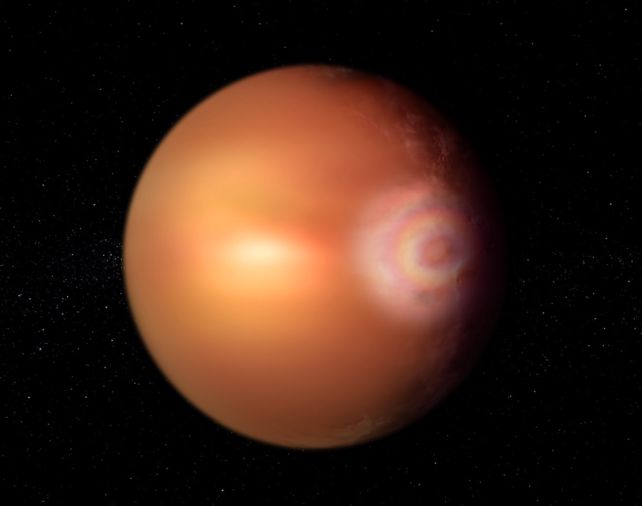[ad_1]
A world notorious for its hellacious situations might have simply been seen recognizing one of many prettiest phenomena ever to grace Earth’s personal ambiance.
Excessive up within the metal-filled skies of a world named WASP-76b, astronomers have discovered proof of a shimmering, multi-hued halo of sunshine often known as a glory. This spectacle has by no means earlier than been seen exterior of the Photo voltaic System, and inside it, solely on two worlds: Earth (in fact) and Venus.
Consisting of a collection of concentric rings round a vibrant middle, these attractive shows of colour require particular situations to type. Gentle must shine on a mist of spherical droplets which are all kind of the identical dimension.
Its look on WASP-76b can subsequently inform us one thing concerning the mysterious ambiance of this very alien world.

“There is a purpose no glory has been seen earlier than exterior our Photo voltaic System – it requires very peculiar situations,” says astronomer Olivier Demangeon, of the Institute of Astrophysics and Area Sciences in Portugal.
“First, you want atmospheric particles which are close-to-perfectly spherical, fully uniform and steady sufficient to be noticed over a very long time. The planet’s close by star must shine straight at it, with the observer – right here Cheops – at simply the suitable orientation.”
WASP-76b is a favourite for planetary scientists. It orbits a yellow-white star a bit of greater than the Solar within the constellation of Pisces, some 640 light-years from Earth. Its orbit across the star is extremely tight, whipping round in simply 1.8 days. That closeness means it is also extremely sizzling, with dayside temperatures exceeding 2,400 levels Celsius (4,350 Fahrenheit) being sizzling sufficient to vaporize iron.
And iron there may be. There are actually clouds of the ingredient within the exoplanet’s puffy ambiance. WASP-76b is 90 p.c of the mass of Jupiter, however round 185 p.c of its dimension.
Because the planet passes in entrance of its star, astronomers are capable of peer into its ambiance. To date, along with iron, they’ve recognized sodium, calcium, chromium, lithium, hydrogen, vanadium, magnesium, nitrogen, manganese, potassium, and barium.
It is one of the vital looked-at worlds within the galaxy. And in all this peering, astronomers have seen one thing unusual concerning the exoplanet’s brightness. In information collected by the European Area Company’s ESA’s CHaracterising ExOPlanet Satellite tv for pc (Cheops), researchers seen an extra in brightness within the japanese terminator, the road that marks the boundary between night time and day.

“That is the primary time that such a pointy change has been detected within the brightness of an exoplanet,” Olivier says. “This discovery leads us to hypothesize that this surprising glow could possibly be attributable to a powerful, localized, and anisotropic (directionally dependent) reflection – the glory impact.”
The sign could be very faint, and additional work shall be wanted to substantiate {that a} glory is certainly what we’re taking a look at on WASP-76b. Nevertheless, whether it is, that can reveal one thing new concerning the composition of the exoplanet’s higher ambiance.
With the impact being analyzed throughout 23 observations in three years, it is clear the spherical aerosol droplets have to be persistently current within the exoplanet’s clouds or replenished at a relentless fee. This, in flip, requires steady long-term temperature situations within the ambiance of WASP-76b.
If the phenomenon does transform an infinite glory, scientists might want to mannequin the world’s ambiance to work out what situations assist its presence.
The invention may have extra far-reaching implications, too. Positively figuring out a glory on WASP-76b would give scientists a blueprint to look for a similar phenomenon on different exoplanets. And with the ability to slim down adjustments in mild may result in the invention of different options, resembling starlight glinting off liquid oceans and lakes, the best way daylight gleams on Earth’s oceans.
Future observations are being deliberate in order that we are able to discover out.
The analysis has been revealed in Astronomy & Astrophysics.
[ad_2]
Supply hyperlink

